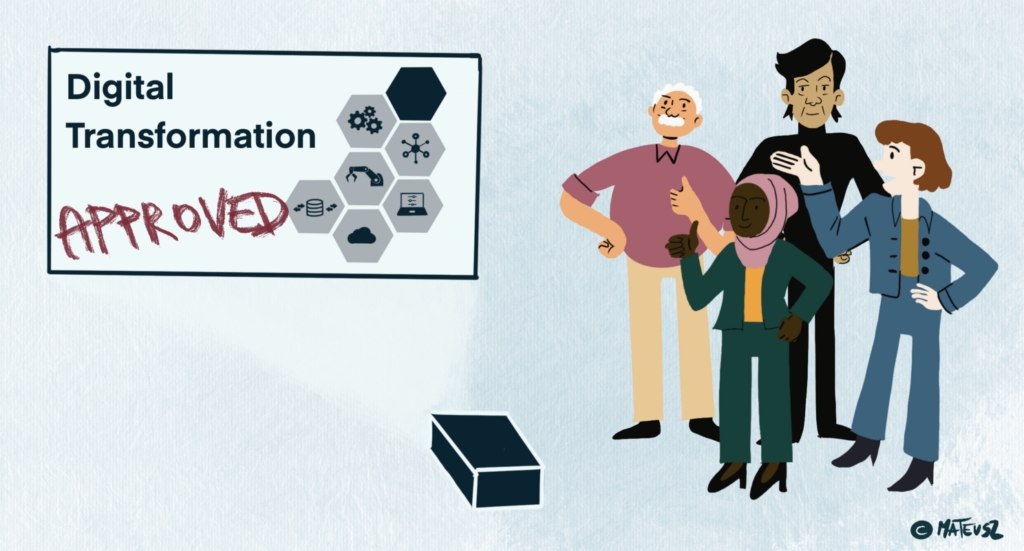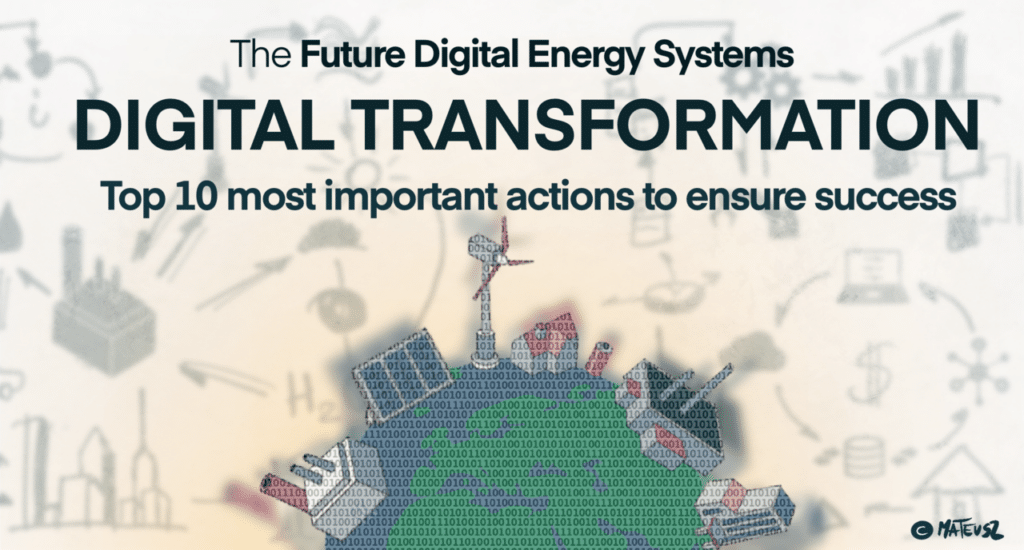Digital Transformation is, nowadays, a buzzing world in industry, which everybody wants to utilize and apply in their business. Nevertheless, it is also starting to be a major cause of confusion, empty promises and big words with no real impact on business performance. Why is there such an extreme dichotomy in the most important enabler for our Future Digital Energy Systems?
According to McKinsey, Deloitte and many more consulting companies, over 70% of digital transformation initiatives have failed. These are not optimistic numbers concerning such a crucial part of the journey ahead. So, what should exemplary digital transformation look like? There is no silver bullet to answer this question, but three main universal guidelines are:
- Make your digital “aim” outcome-focused and human-centered
- Treat the business as a unified whole
- Take an experimental, scale-later approach
Out of those guidelines, I have synthesized the ten most significant actions an enterprise and its leaders need to take to ensure successful digital transformation. Based on my experience, it would be extremely difficult to be successful if any of the points below are not addressed properly.
1. Vision — Make a plan for the plant of the future.

Vision without action is merely a dream. Action without vision just passes the time. Vision with action can change the world.
Joel A. Baker
I will not be original in mentioning vision in the first place. As Joel A. Baker said in a quote above — lack of vision is the first step to creating great plans without impact on reality. Vision does not have to be another corporate and general “blah, blah, blah” but can be amalgamated with business model and strategy. Like, i.e. Value Disciplines Model¹, where the company is created around three different backbones:
- Products
- Customer
- The lowest costs

Source: Yokogawa. Digital Transformation in Process Industries. ²
Being a product-oriented company sets your focus on creating great products. The whole strategy is designed around what you deliver. Apple and Tesla are the best examples of companies which bet on product differentiation.
Shifting focus from what to how or from product to experience defines enterprises focused more on customer intimacy. Well-known examples of such companies are Amazon and Lexus.
Ultimately, operational excellence is built around the best-in-price principle. Increasing efficiency and decreasing costs to provide affordable products. IKEA and Toyota are proud advocates of this strategy.
These are principal business decisions that do not have to be part of the digital transformation journey, but they always set the path for strategy and expected results – plant of the future. Concerning The Future Digital Energy Systems, no matter what business model a company chooses, it must be built on sustainability principles and incorporate and support all possible routes to a fair and consistent energy transition.
2. Sponsors – get C-level buy in.

Digital Transformation is not an out-of-the-box product with a clear path of implementation, it is not tweaking the business. It is about completely new narratives and transforming the whole company: rewriting business processes, reassigning people and re-equipping with new technology. Without strong support and commitment from digital-savvy executives, the digital journey can be very daunting, if possible at all.
Here we get to the bottom of it – it is difficult to have real buy-in from executives if they do not understand why, what and how things will change. Digital awareness at the c-level is one of the key enablers for a successful journey. As MIT analysis³ shows, there is a big divergence in digital savviness between the members of the c-level crew. One of the ideas to collectively enhance awareness of the entire team is to assign a Chief Digital Officer, who as a member of executives will not only take leadership of Digital Transformation but also build a solid digital foundation amongst all c-level members.
3. Change – The main focus should be on change management.
DX is not a typical Management of Change process. Digital Transformation, as explained above, is rewriting all enterprise principles, and it has to start with senior management leadership.
- First, understand how your company is working in reality, not on paper.
- Then, start redesigning and modifying standard processes to promote digital tools and a digital way of thinking.
- This will initiate momentum and enthusiasm, quickly eroding from top to bottom.
- As a result, natural digital leaders supporting transformation on an operational level will appear.
Four simple steps get knotty while confronting reality, and can lead to the federalization of the enterprise, which is contradictory to a major KPI of every corporation – unification. Change Management, especially when we talk about digital transformation, has to be led by a program manager, who keeps focus and discipline amongst different teams and ensures that everybody is aiming in the same direction.
O Captain! My Captain! like Whitman’s admiration of Lincoln’s leadership or, more actually, Keating’s mentorship, should be in the intercompany newsletters and intranets showing consistent program manager guidance in every department, discipline, or aspect of the enterprise.
4. Team — cross-department task force.
What would be the change management and leadership of a program manager without his teams? 4ᵗʰ flavour of successful Digital Transformation is dedicated teams. This is something different to what we got used to having in the past. Business transformation, as explained earlier, does not know siloes and departments, so the teams which should lead the digitalization. Finance, Maintenance, HR, Safety, Production and IT working on transformation opportunities.
Cross-departmental, multidisciplinary, inclusive and oriented on the outcome (your customer, right?) should be engraved just under the name of each group. But that is not all. Each team has to be accountable, responsible and decisive within their scope of work. Providing enough freedom to make a decision is by far the most difficult and unacceptable aspect of modern taskforces. Management (of the teams and company) should ensure collaboration between the team and appropriate technology leaders (external or internal) have to be engaged as subject-matter experts for each group. This will release technological pressure on very often non-technological team members and increase focus on the results (not the tools).
5. Partnership – learn from the best to beat the best.

Focus on your core business and build expertise where your customer expects it from you. Digital Transformation is a multidisciplinary journey and, with the world and technology changing rapidly, it does not make sense to build in-house expertise in all domains. Learn to outsource large parts of your journey to partners. Learn as a person and an organization to trust external parties and gain experience from their knowledge and mistakes.
The crucial point is how we understand partnership. It is not a third-party supplier which delivers the exact scope defined in battery limits. The elementary explanation which defines the foremost partnership is 1+1=10. Real partners in business are not filling the gaps, real partners are multiplying the outcome by filling the gaps and providing expertise and experience to the whole process.
6. Priorities – set priorities and do it right.
What I have learned in my professional life is that one of the key ingredients of any successful project is focus. Contrary, the focus is relatively difficult in such a holistic project as digital transformation. To achieve adequate clarity while maintaining a wide picture of the whole transformation, it is mandatory to set certain priorities.
Guidelines, roadmaps and strategies are not the same as priorities. Where should you start changing? How do you communicate with customers and suppliers, how do you exchange information within your company or maybe first work out security or intelligence issues in Operation Technology (OT) domain or even maybe first focus on digital tools for collaboration, training or any other organizational changes?
Where are the low-hanging fruits?
These are the very first questions that came up in deductive reasoning of digital transformation. If you choose wrong and lose time and patience on projects which do not bring expected results within the expected timeframe, you can easily lose momentum and support. Setting the right priorities is crucial, but thankfully we have great tools on the market to support this process. More on one of the best – Smart Industry Readiness Index – you can find in the video below.
7. Technology – always as a backbone.
All points above consider either processes or people in an organization. We cannot forget about technology, as it is the main enabler of digital transformation. Technology is crucial, not as a dedicated solution and possible use cases but as a foundation of whole transformation and fundaments for a company-wide information lake. The main goal for technology supporting digital transformation is to enable access to the right information at the right time, i.e.:
- Access to information across the whole organization (vertical integration)
- Access to information from/to partners and customers (horizontal integration)
- Integration of information about the product for innovation, support, and legislation purposes (product lifecycle integration)
- Digital self-serve technology for employees’ and business partners’ use
In a McKinsey survey⁴, we can find that the top three technologies that contribute most to digital transformation are, in fact, digital infrastructure (the foundation that defines a way of integrating data and information).

Source: McKinsey & Company. Unlocking success in digital transformation.
8. Innovation – become a lab for new tech in 3 steps.
Once we have a strategy, appropriate people, and a technology backbone, we can start to challenge old ways of working, generating ideas, testing them, and, in most cases, failing. That is OK. Trying, failing, and learning combined with stable financing is one of the best ways to generate organic progress for organizations on the digitalization journey⁵. Giving enough space to experiment with new ideas allows for a quick learning curve and more accurate and faster decisions. After successful siloed tests of the projects, try to embed them in your organization. Again, try, fail and learn. Once successful, you are ready to scale up.
9 . New workforce culture.
Changing company culture is by far the most time-consuming and challenging point. Having an appetite, mandate, or will to change the culture is insufficient. You need to create a movement that organically redefines the workforce ecosystem.
Considering what we have learned during the COVID-19 pandemic, the very first steps of a new opening in workforce culture should be:
- Redefine individuals’ roles and responsibilities so they align with digital transformation goals
- New ways of working — role mobility, open work environments or continuous learning – enhance collaboration
- Engage employees in integrator roles to support transformation
- Great space in the work environment – to release creativity
- Establish new ways of communication (internal and external)
10. Budget – reserve a budget … or two.

We could not skip the cost of the digital transformation. All those changes are a significant financial burden for the company, but the most challenging aspect is not the value but the business case. Most digital projects are not typical CAPEX projects with clear ROI calculations, scope definitions, and responsibilities. With digital transformation, we need to introduce agile methodology to project management and investment planning and controlling. And this has to apply to both internal and external projects.
Nevertheless, given the market’s current state, energy transition, and the world’s increased variability, the money spent on digital transformation may decide your license to operate.
Digital Transformation is a parallel journey to Energy Transition with a significant number of crossings and the same target—the Future of Digital Energy Systems. We cannot have digitalization without decarbonization, just as there is no decarbonization without digitalization.




